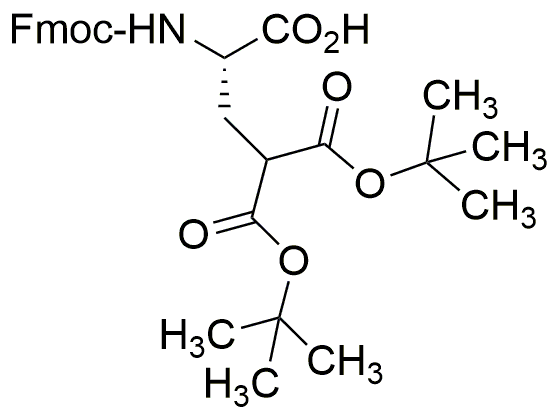Fmoc-g-carboxy g-(di-tert-butyl ester)-L-glutamic acid is widely utilized in research focused on:
- Peptide Synthesis: This compound serves as a key building block in the synthesis of peptides, allowing researchers to create complex proteins with specific functionalities. Its protective groups facilitate selective reactions, enhancing the efficiency of the synthesis process.
- Drug Development: In pharmaceutical research, it is used to design and optimize peptide-based drugs. The ability to modify the structure easily helps in tailoring compounds for better efficacy and reduced side effects.
- Bioconjugation: This chemical is valuable in bioconjugation techniques, where it aids in attaching biomolecules to surfaces or other molecules, improving drug delivery systems and diagnostic tools.
- Research in Neuroscience: It plays a role in studying neurotransmitter systems by enabling the synthesis of glutamate analogs, which are crucial for understanding synaptic transmission and potential therapeutic targets.
- Material Science: The compound is also explored in the development of smart materials, where its unique properties can be harnessed to create responsive systems for various applications, including sensors and drug delivery vehicles.
General Information
Properties
Safety and Regulations
Applications
Fmoc-g-carboxy g-(di-tert-butyl ester)-L-glutamic acid is widely utilized in research focused on:
- Peptide Synthesis: This compound serves as a key building block in the synthesis of peptides, allowing researchers to create complex proteins with specific functionalities. Its protective groups facilitate selective reactions, enhancing the efficiency of the synthesis process.
- Drug Development: In pharmaceutical research, it is used to design and optimize peptide-based drugs. The ability to modify the structure easily helps in tailoring compounds for better efficacy and reduced side effects.
- Bioconjugation: This chemical is valuable in bioconjugation techniques, where it aids in attaching biomolecules to surfaces or other molecules, improving drug delivery systems and diagnostic tools.
- Research in Neuroscience: It plays a role in studying neurotransmitter systems by enabling the synthesis of glutamate analogs, which are crucial for understanding synaptic transmission and potential therapeutic targets.
- Material Science: The compound is also explored in the development of smart materials, where its unique properties can be harnessed to create responsive systems for various applications, including sensors and drug delivery vehicles.
Documents
Safety Data Sheets (SDS)
The SDS provides comprehensive safety information on handling, storage, and disposal of the product.
Product Specification (PS)
The PS provides a comprehensive breakdown of the product’s properties, including chemical composition, physical state, purity, and storage requirements. It also details acceptable quality ranges and the product's intended applications.
Certificates of Analysis (COA)
Search for Certificates of Analysis (COA) by entering the products Lot Number. Lot and Batch Numbers can be found on a product’s label following the words ‘Lot’ or ‘Batch’.
*Catalog Number
*Lot Number
Certificates Of Origin (COO)
This COO confirms the country where the product was manufactured, and also details the materials and components used in it and whether it is derived from natural, synthetic, or other specific sources. This certificate may be required for customs, trade, and regulatory compliance.
*Catalog Number
*Lot Number
Safety Data Sheets (SDS)
The SDS provides comprehensive safety information on handling, storage, and disposal of the product.
DownloadProduct Specification (PS)
The PS provides a comprehensive breakdown of the product’s properties, including chemical composition, physical state, purity, and storage requirements. It also details acceptable quality ranges and the product's intended applications.
DownloadCertificates of Analysis (COA)
Search for Certificates of Analysis (COA) by entering the products Lot Number. Lot and Batch Numbers can be found on a product’s label following the words ‘Lot’ or ‘Batch’.
*Catalog Number
*Lot Number
Certificates Of Origin (COO)
This COO confirms the country where the product was manufactured, and also details the materials and components used in it and whether it is derived from natural, synthetic, or other specific sources. This certificate may be required for customs, trade, and regulatory compliance.


